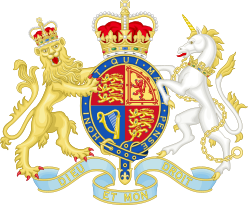Dudley Ryder, 1. Earl of Harrowby
Dudley Ryder, 1. Earl of Harrowby PC (* 22. Dezember 1762; † 26. Dezember 1847) war ein britischer Adliger und Politiker der Tory-Partei.
Leben
Ryder war der älteste Sohn von Nathaniel Ryder, 1. Baron Harrowby, und seiner Frau Elizabeth. Er besuchte zunächst die Harrow School und studierte dann am St. John’s College an der University of Cambridge.
Er vertrat von 1784 bis 1803 den Bezirk Tiverton im Unterhaus. Den Sitz hatte zuvor unter anderen sein Vater innegehabt. Ab 1790 hatte er verschiedene nachgeordnete Regierungsämter inne. Insbesondere war er von 1790 bis 1801 Vizepräsident des Board of Trade.
Als sein Vater 1803 starb, erbte er dessen Titel als 2. Baron Harrowby und stieg ins House of Lords auf. Von 1804 bis 1805 war er Außenminister unter William Pitt,[1] der ein enger Freund von Ryder war. Im Anschluss daran übernahm er das Amt des Chancellor of the Duchy of Lancaster.[2] Pitt beauftragte ihn mit wichtigen Missionen nach Österreich, Russland und Preußen. 1809 wurde Ryder zum Earl of Harrowby erhoben. Von 1812 bis 1827 hatte dann das Amt des Lord President of the Council inne.[3]
Das Amt des Premierministers, das ihm nach dem Tode von George Canning angetragen worden war, lehnte Ryder ab, weil er nicht unter König Georg IV. dienen wollte. Danach übernahm er keine Ämter mehr, blieb aber aktiv in der Politik; so spielte er eine prominente Rolle bei der Durchsetzung des Reform Act 1832.
Familie
Ryder war seit 1795 mit Susan Leveson-Gower, einer Tochter von Granville Leveson-Gower, 1. Marquess of Stafford. Mit ihr zusammen hatte er acht Kinder.
Er starb im Alter von 85 Jahren. Seine Titel gingen auf seinen ältesten Sohn Dudley über.
Literatur
- Harrowby, Dudley Ryder, 1st Earl of. In: Encyclopædia Britannica. 11. Auflage. Band 13: Harmony – Hurstmonceaux. London 1910, S. 28 (englisch, Volltext [Wikisource]).
Weblinks
- Dudley Ryder, 1st Earl of Harrowby auf thepeerage.com, abgerufen am 21. Juli 2015.
- Dudley Ryder im Hansard (englisch)
Einzelnachweise
- ↑ Powicke, Fryde: Handbook of British Chronology, Second Edition. London 1961, S. 116
- ↑ Powicke, Fryde: Handbook of British Chronology, Second Edition. London 1961, S. 141
- ↑ Powicke, Fryde: Handbook of British Chronology, Second Edition. London 1961, S. 138
| Vorgänger | Amt | Nachfolger |
|---|---|---|
| Titel neu geschaffen | Earl of Harrowby 1809–1847 | Dudley Ryder |
| Nathaniel Ryder | Baron Harrowby 1803–1847 | Dudley Ryder |
| John Villiers | Comptroller of the Household 1790–1791 | George Parker |
| Henry Dundas | Treasurer of the Navy 1800–1801 | Charles Bathurst |
| Robert Hobart | Chancellor of the Duchy of Lancaster 1805–1806 | Edward Smith-Stanley |
| Robert Dundas | President of the Board of Control 1809 | Robert Dundas |
| Henry Addington | Lord President of the Council 1812–1827 | William Bentinck |
| Personendaten | |
|---|---|
| NAME | Ryder, Dudley, 1. Earl of Harrowby |
| ALTERNATIVNAMEN | Harrowby, Dudley Ryder, 2. Baron |
| KURZBESCHREIBUNG | britischer Politiker |
| GEBURTSDATUM | 22. Dezember 1762 |
| STERBEDATUM | 26. Dezember 1847 |
Auf dieser Seite verwendete Medien
Autor/Urheber: Sodacan, Lizenz: CC BY-SA 3.0
Royal Coat of Arms of the United Kingdom of Great Britain and Northern Ireland in the style used by the Government of Queen Elizabeth II from 1952 to 2022 (as used in all places except Scotland).
| “ | Quarterly, First and Fourth Gules three lions passant guardant in pale Or armed and langued Azure (for England), Second quarter Or a lion rampant within a double tressure flory counter-flory Gules (for Scotland), Third quarter Azure a harp Or stringed Argent (for Ireland), the whole surrounded by the Garter; for a Crest, the imperial crown Proper; for Supporters, dexter a lion rampant guardant Or crowned as the Crest, sinister a unicorn Argent armed, crined and unguled Proper, gorged with a coronet Or composed of crosses patée and fleurs de lys a chain affixed thereto passing between the forelegs and reflexed over the back also Or; Motto 'Dieu et mon Droit’ ('God and my Right') below the shield. | ” |
- PINCHES, J.H & R.V., The Royal Heraldry of England, 1974, Heraldry Today.


